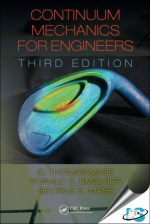Tab Article
Continuum Mechanics for Engineers, Third Edition provides engineering students with a complete, concise, and accessible introduction to advanced engineering mechanics. The impetus for this latest edition was the need to suitably combine the introduction of continuum mechanics, linear and nonlinear elasticity, and viscoelasticity for a graduate-level course sequence. An outgrowth of course notes and problems used to teach these subjects, the third edition of this bestselling text explores the basic concepts behind these topics and demonstrates their application in engineering practice.
Presents Material Consistent with Modern Literature
A new rearranged and expanded chapter on elasticity more completely covers Saint-Venant’s solutions. Subsections on extension, torsion, pure bending and flexure present an excellent foundation for posing and solving basic elasticity problems. The authors’ presentation enables continuum mechanics to be applied to biological materials, in light of their current importance. They have also altered the book’s notation—a common struggle for many students—to better align it with modern continuum mechanics literature. This book addresses students’ need to understand the sophisticated simulation programs that use nonlinear kinematics and various constitutive relationships. It includes an introduction to problem solution using MATLAB®, emphasizing this language’s value in enabling users to stay focused on fundamentals.
This book provides information that is useful in emerging engineering areas, such as micro-mechanics and biomechanics. With an abundance of worked examples and chapter problems, it carefully explains necessary mathematics as required and presents numerous illustrations, giving students and practicing professionals an excellent self-study guide to enhance their skills. Through a mastery of this volume’s contents and additional rigorous finite element training, they will develop the mechanics foundation necessary to skillfully use modern, advanced design tools.


